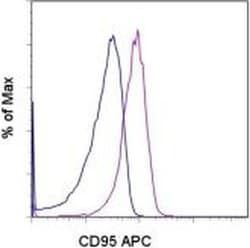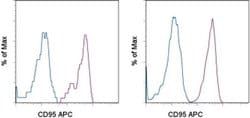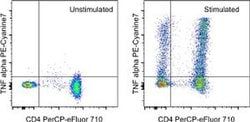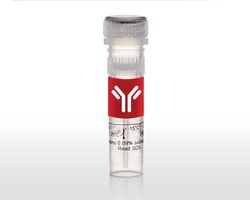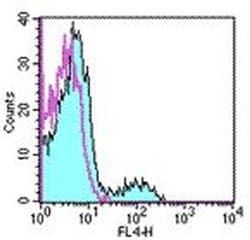CD178 (Fas Ligand) Monoclonal Antibody (MFL3), APC, eBioscience™, Invitrogen™
Manufacturer: Fischer Scientific
Select a Size
| Pack Size | SKU | Availability | Price |
|---|---|---|---|
| Each of 1 | 50-152-47-Each-of-1 | In Stock | ₹ 11,392.00 |
50-152-47 - Each of 1
In Stock
Quantity
1
Base Price: ₹ 11,392.00
GST (18%): ₹ 2,050.56
Total Price: ₹ 13,442.56
Antigen
CD178 (Fas Ligand)
Classification
Monoclonal
Concentration
0.2 mg/mL
Formulation
PBS with 0.09% sodium azide; pH 7.2
Gene Accession No.
P41047
Gene Symbols
Fasl
Purification Method
Affinity chromatography
Regulatory Status
RUO
Gene ID (Entrez)
14103
Content And Storage
4° C, store in dark, DO NOT FREEZE!
Form
Liquid
Applications
Flow Cytometry
Clone
MFL3
Conjugate
APC
Gene
Fasl
Gene Alias
ADAM10-processed FasL form; ALPS1B; APL; Apoptosis (APO 1) antigen ligand 1; apoptosis (APO-1) antigen ligand 1; Apoptosis (APO-1) antigen ligand 1 (Fas antigen ligand); apoptosis antigen ligand; APT1LG1; APTL; CD178; CD178 antigen; CD95 ligand; CD95 ligand protein;Generalized lymphoproliferative disease (Gld); Cd95l; CD95-L; CD95L protein; fas antigen ligand; Fas ligand; Fas ligand (TNF superfamily, member 6); Fasl; Fas-L; FasL ICD; FasL intracellular domain; Faslg; Fas-LG; generalized lymphoproliferative disease; gld; mutant tumor necrosis factor family member 6; Receptor-binding FasL ectodomain; sFasL; Soluble Fas ligand; soluble form; SPA; SPPL2A-processed FasL form; TNFL; Tnfsf6; TNLG1A; Tumor necrosis factor (ligand) superfamily member 6; Tumor necrosis factor (ligand) superfamily member 6 (apoptosis (APO-1) antigen ligand 1) (Fas antigen ligand); Tumor necrosis factor (ligand) superfamily, member 6 (apoptosis (APO-1) antigen ligand 1) (Fas antigen ligand); Tumor necrosis factor ligand; tumor necrosis factor ligand 1A; tumor necrosis factor ligand superfamily member 6; Tumor necrosis factor ligand superfamily member 6 (TNFL6 / TNFSF6); Tumor necrosis factor ligand superfamily member 6, membrane form; Tumor necrosis factor ligand superfamily member 6, soluble form
Host Species
Armenian Hamster
Quantity
25 μg
Primary or Secondary
Primary
Target Species
Mouse
Product Type
Antibody
Isotype
IgG
Related Products
Description
- Description: The MFL3 monoclonal antibody reacts with mouse Fas (CD95) Ligand, a 40 kDa type II transmembrane glycoprotein
- FasL is a member of the TNF family and is expressed by mouse activated T cells
- The interaction of FasL with its receptor CD95 induces Fas-mediated killing
- It has been reported that the human FasL antigen is cleaved from the surface by matrix metalloproteinases (MMPs), resulting in a 26 kDa soluble form
- The degree of sensitivity for the mouse antigen to MMPs has not been reported
- Applications Tested: This MFL3 antibody has been tested by flow cytometric analysis of mouse FasL-transfected cells
- This can be used at less than or equal to 0.25 μg per test
- A test is defined as the amount (μg) of antibody that will stain a cell sample in a final volume of 100 μL
- Cell number should be determined empirically but can range from 10^5 to 10^8 cells/test
- It is recommended that the antibody be carefully titrated for optimal performance in the assay of interest
- Excitation: 633-647 nm; Emission: 660 nm; Laser: Red Laser
- Filtration: 0.2 μm post-manufacturing filtered
- CD178 (Fas ligand, FasL) is a type-II-membrane protein, whose N-terminus is in the cytoplasm and its C-terminal region extends into the extracellular space
- Its receptor, FasR, is a cell-surface-type-I-membrane protein and a member of the tumor necrosis factor (TNF) and nerve growth factor (NGF) receptor family
- As a member of the TNF-cytokine family CD178 induces apoptosis when interacting with FasR
- CD178 may exist as either membrane bound (45 kD) or soluble forms (26 kD)
- The soluble protein can be released from cells upon cleavage by metalloproteinases
- Binding of CD178 to Fas leads to oligomerization of the receptor and triggers apoptotic cell death through the interaction of other proteins
- CD178 is predominantly expressed in activated T-lymphocytes and natural killer (NK) cells also it is expressed in the tissues of immune-privilege sites such as testis and eye
- CD178 expression is also reported in various tissues as thymus, liver, ovary, lung, heart and kidney
- It is assumed that induction of apoptosis through CD178 is predominantly involved in anti-viral immune responses
- CD178 is a cell surface molecule belonging to the tumor necrosis factor family, binds to its receptor Fas, thus inducing apoptosis
- Various cells express FAS, where CD178 is expressed predominantly on activated T cells
- FAS and CD178 are involved in the down-regulation of immune reactions as well as T cell-mediated cytotoxicity
- CD178 concentration has also been shown to be associated with atherosclerosis and inflammatory disease, in patients with hypertension
- The Fas/ CD178 system has been shown to play a role in a number of human diseases, for example AIDS, hepatitis or cancer.

